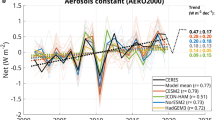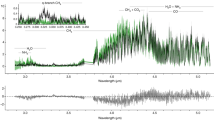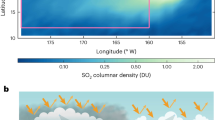Abstract
Pluto’s atmosphere is cold and hazy1,2,3. Recent observations1 have shown it to be much colder than predicted theoretically4, suggesting an unknown cooling mechanism1. Atmospheric gas molecules, particularly water vapour, have been proposed as a coolant; however, because Pluto’s thermal structure is expected to be in radiative–conductive equilibrium4,5,6,7,8,9, the required water vapour would need to be supersaturated by many orders of magnitude under thermodynamic equilibrium conditions9. Here we report that atmospheric hazes, rather than gases, can explain Pluto’s temperature profile. We find that haze particles have substantially larger solar heating and thermal cooling rates than gas molecules, dominating the atmospheric radiative balance from the ground to an altitude of 700 kilometres, above which heat conduction maintains an isothermal atmosphere. We conclude that Pluto’s atmosphere is unique among Solar System planetary atmospheres, as its radiative energy equilibrium is controlled primarily by haze particles instead of gas molecules. We predict that Pluto is therefore several orders of magnitude brighter at mid-infrared wavelengths than previously thought—a brightness that could be detected by future telescopes.
This is a preview of subscription content, access via your institution
Access options
Access Nature and 54 other Nature Portfolio journals
Get Nature+, our best-value online-access subscription
$29.99 / 30 days
cancel any time
Subscribe to this journal
Receive 51 print issues and online access
$199.00 per year
only $3.90 per issue
Buy this article
- Purchase on Springer Link
- Instant access to full article PDF
Prices may be subject to local taxes which are calculated during checkout




Similar content being viewed by others
References
Gladstone, G. R. et al. The atmosphere of Pluto as observed by New Horizons. Science 351, aad8866 (2016)
Young, L. A. et al. Structure and composition of Pluto’s atmosphere from the New Horizons solar ultraviolet occultation. Icarus 300, 174–199 (2017)
Cheng, A. F. et al. Haze in Pluto’s atmosphere. Icarus 290, 112–133 (2017)
Zhu, X. et al. The density and thermal structure of Pluto’s atmosphere and associated escape processes and rates. Icarus 228, 301–314 (2014)
Yelle, R. V. & Lunine, J. I. Evidence for a molecule heavier than methane in the atmosphere of Pluto. Nature 339, 288–290 (1989)
Hubbard, W. B. Nonisothermal Pluto atmosphere models. Icarus 84, 1–11 (1990)
Lellouch, E. Pluto’s atmospheric structure: clear vs hazy models. Icarus 108, 255–264 (1994)
Strobel, D. F. et al. On the vertical thermal structure of Pluto’s atmosphere. Icarus 120, 266–289 (1996)
Strobel, D. F. & Zhu, X. Comparative planetary nitrogen atmospheres: density and thermal structures of Pluto and Triton. Icarus 291, 55–64 (2017)
Tomasko, M. G. Heat balance in Titan’s atmosphere. Planet. Space Sci. 56, 648–659 (2008)
Zhang, X. et al. Aerosol influence on energy balance of the middle atmosphere of Jupiter. Nat. Commun. 6, 10231 (2015)
Lavvas, P. et al. Aerosol growth in Titan’s ionosphere. Proc. Natl Acad. Sci. USA 110, 2729–2734 (2013)
Gao, P. et al. Constraints on the microphysics of Pluto’s photochemical haze from New Horizons observations. Icarus 287, 116–123 (2017)
Bertrand, T. & Forget, F. 3D modeling of organic haze in Pluto’s atmosphere. Icarus 287, 72–86 (2017)
Imanaka, H. et al. Laboratory experiments of Titan tholin formed in cold plasma at various pressures: implications for nitrogen-containing polycyclic aromatic compounds in Titan haze. Icarus 168, 344–366 (2004)
West, R. et al. in Titan: Surface, Atmosphere and Magnetosphere (eds Mueller-Wodarg, I. et al.) 285–321 (Cambridge Univ. Press, 2014)
Khare, B. N. et al. Optical constants of organic tholins produced in a simulated titanian atmosphere: from soft X-ray to microwave frequencies. Icarus 60, 127–137 (1984)
Lavvas, P. et al. The detached haze layer in Titan’s mesosphere. Icarus 201, 626–633 (2009)
Ramirez, S. I. et al. Complex refractive index of Titan’s aerosol analogues in the 200–900 nm domain. Icarus 156, 515–529 (2002)
Vinatier, S. et al. Optical constants of Titan’s stratospheric aerosols in the 70–1500 cm−1 spectral range constrained by Cassini/CIRS observations. Icarus 219, 5–12 (2012)
Buratti, B. J. et al. Global albedos of Pluto and Charon from LORRI New Horizons observations. Icarus 287, 207–217 (2017)
Tomasko, M. G. et al. A model of Titan’s aerosols based on measurements made inside the atmosphere. Planet. Space Sci. 56, 669–707 (2008)
Wong, M. L. et al. The photochemistry of Pluto’s atmosphere as illuminated by New Horizons. Icarus 287, 110–115 (2017)
Anderson, C. M. & Samuelson, R. E. Titan’s aerosol and stratospheric ice opacities between 18 and 500 μm: vertical and spectral characteristics from Cassini CIRS. Icarus 212, 762–778 (2011)
McKay, C. P., Pollack, J. B. & Courtin, R. The thermal structure of Titan’s atmosphere. Icarus 80, 23–53 (1989)
Herbert, F. & Sandel, B. R. CH4 and haze in Triton’s lower atmosphere. J. Geophys. Res. Space Phys. 96, 19241–19252 (1991)
Lellouch, E. et al. Thermal properties of Pluto’s and Charon’s surfaces from Spitzer observations. Icarus 214, 701–716 (2011)
Glasse, A. et al. The Mid-Infrared Instrument for the James Webb Space Telescope, IX: predicted sensitivity. Publ. Astron. Soc. Pacif. 127, 686–695 (2015)
Lellouch, E. et al. Detection of CO and HCN in Pluto’s atmosphere with ALMA. Icarus 286, 289–307 (2017)
Moore, M. H. et al. Infrared spectra and optical constants of nitrile ices relevant to Titan’s atmosphere. Astrophys. J. Suppl. Ser. 191, 96–112 (2010)
Strobel, D. F. N2 escape rates from Pluto’s atmosphere. Icarus 193, 612–619 (2008)
Hinson, D. P. et al. Radio occultation measurements of Pluto’s neutral atmosphere with New Horizons. Icarus 290, 96–111 (2017)
Zhang, X. et al. Radiative forcing of the stratosphere of Jupiter, Part I: atmospheric cooling rates from Voyager to Cassini. Planet. Space Sci. 88, 3–25 (2013)
Rothman, L. S. et al. The HITRAN2012 molecular spectroscopic database. J. Quant. Spectrosc. Radiat. Transf. 130, 4–50 (2013)
Häger, J., Krieger, W. & Pfab, J. Collisional deactivation of laser-excited acetylene by H2, HBr, N2 and CO. J. Chem. Soc. Faraday Trans. 2. 77, 469–476 (1981)
Lavvas, P., Sander, M., Kraft, M. & Imanaka, H. Surface chemistry and particle shape: processes for the evolution of aerosols in Titan’s atmosphere. Astrophys. J. 728, 80 (2011)
Zhang, X ., West, R. A ., Banfield, D. & Yung, Y. L. Stratospheric aerosols on Jupiter from Cassini observations. Icarus 226, 159–171 (2013); erratum 266, 433–434 (2016)
Lavvas, P., Yelle, R. V. & Griffith, C. A. Titan’s vertical aerosol structure at the Huygens landing site: constraints on particle size, density, charge, and refractive index. Icarus 210, 832–842 (2010)
Filippov, A. V. & Rosner, D. E. Energy transfer between an aerosol particle and gas at high temperature ratios in the Knudsen transition regime. Int. J. Heat Mass Transfer 43, 127–138 (2000)
Burke, J. R. & Hollenbach, D. J. The gas-grain interaction in the interstellar medium—thermal accommodation and trapping. Astrophys. J. 265, 223–234 (1983)
Acknowledgements
We thank Y. Yung, B. Bézard, E. Lellouch, M. Liang, X. Zhu and P. Gao for discussions. X.Z. acknowledges partial support from NASA Solar System Workings grant NNX16AG08G. D.F.S. acknowledges partial support from NASA’s New Horizons Mission. H.I. acknowledges support from NASA Cassini Data Analysis grant NNX14AF61G and NASA Exoplanet Research grant NNX15AQ73G.
Author information
Authors and Affiliations
Contributions
X.Z. conceived the research, performed the calculations and wrote the manuscript. D.F.S. provided the New Horizons data and the gas-only model and assisted with analysis. H.I. provided the refractive indices of haze particles. D.F.S. and H.I. contributed to manuscript writing.
Corresponding author
Ethics declarations
Competing interests
The authors declare no competing financial interests.
Additional information
Reviewer Information Nature thanks R. West and Y. Yung for their contribution to the peer review of this work.
Publisher's note: Springer Nature remains neutral with regard to jurisdictional claims in published maps and institutional affiliations.
Extended data figures and tables
Extended Data Figure 1 Properties of haze in Pluto’s atmosphere as a function of altitude.
Vertical distributions of: a, the mean particle size; b, the observed haze attenuation factor at the Alice far-ultraviolet (FUV) channel; c, particle number density; and d, scaling factors applied to the haze k values in our balanced model.
Extended Data Figure 2 Optical properties of haze in Pluto’s atmosphere as a function of wavelength.
a, Total vertical optical depths of haze for two cases: if the particles in the near-surface layers are Mie spheres, or if they are fractal aggregates. b, Extinction efficiencies for a 10-nm monomer particle and an aggregated particle composed of 10-nm monomers with a volume-equivalent radius of 0.15 μm (ref. 3). Extinction efficiency for the aggregates is defined as the calculated total extinction cross-section divided by the cross-section of equal-volume spheres22. c, Single scattering albedos as a function of wavelength. The contribution of the spectral region from 1 μm to 7 μm (grey lines) to the haze heating rate is less than 1% and is omitted here.
Extended Data Figure 3 Reflectivity I/F values as a function of phase angle.
LORRI observations at an altitude of 45 km (black) and near the surface (blue) are shown with squares3. Simulated phase functions from multiple solutions of aggregates (composed of 10-nm monomers, 30-nm monomers or 50-nm monomers) are scaled to fit the observations.
Extended Data Figure 4 Sensitivity study of haze heating and cooling rates.
a, b, Modelled heating rates. c, d, Modelled cooling rates. Solid lines represent the results obtained if the near-surface haze layers are composed of Mie-sphere particles with radii of 0.5 μm. Dashed lines show the results obtained if the near-surface particles are instead aggregates identical to those at 45 km (consistent with Extended Data Fig. 3). b, d, Zoomed-in versions of a and c, respectively, for the lower 100-km region.
Rights and permissions
About this article
Cite this article
Zhang, X., Strobel, D. & Imanaka, H. Haze heats Pluto’s atmosphere yet explains its cold temperature. Nature 551, 352–355 (2017). https://doi.org/10.1038/nature24465
Received:
Accepted:
Published:
Issue Date:
DOI: https://doi.org/10.1038/nature24465
This article is cited by
-
Optical properties of organic haze analogues in water-rich exoplanet atmospheres observable with JWST
Nature Astronomy (2023)
-
A bimodal distribution of haze in Pluto’s atmosphere
Nature Communications (2022)
-
Haze evolution in temperate exoplanet atmospheres through surface energy measurements
Nature Astronomy (2021)
-
A major ice component in Pluto’s haze
Nature Astronomy (2020)
-
Aerosol composition of hot giant exoplanets dominated by silicates and hydrocarbon hazes
Nature Astronomy (2020)
Comments
By submitting a comment you agree to abide by our Terms and Community Guidelines. If you find something abusive or that does not comply with our terms or guidelines please flag it as inappropriate.



